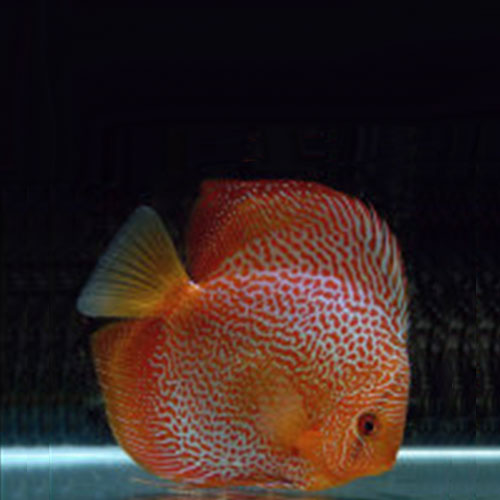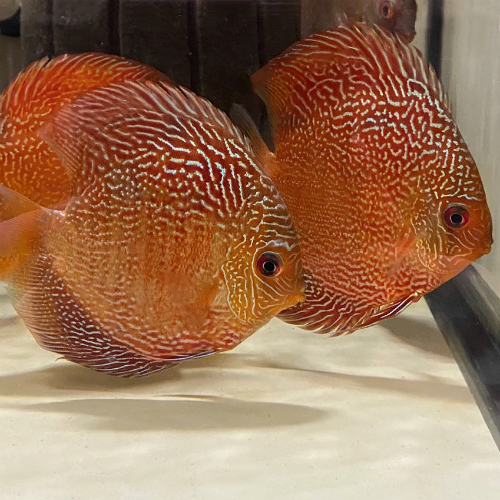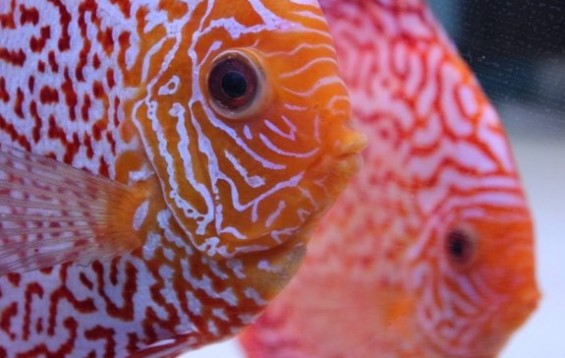You are looking for information, articles, knowledge about the topic nail salons open on sunday near me discus snake skin red on Google, you do not find the information you need! Here are the best content compiled and compiled by the toplist.prairiehousefreeman.com team, along with other related topics such as: discus snake skin red red panda discus, jack wattley discus, blue snakeskin discus, leopard discus, yellow snakeskin discus, red rafflesia discus, discus fish, red turquoise discus
Table of Contents
Red Snakeskin Discus – Wattley Discus
- Article author: wattleydiscus.com
- Reviews from users: 31342
Ratings
- Top rated: 3.3
- Lowest rated: 1
- Summary of article content: Articles about Red Snakeskin Discus – Wattley Discus Updating …
- Most searched keywords: Whether you are looking for Red Snakeskin Discus – Wattley Discus Updating As the name suggests, this Red Snakeskin Discus variant’s body comes with red spots on a white background.
- Table of Contents:
Additional information
Reviews
Related products
Coerulea Discus
Leopard Snakeskin Discus
Striated Red Discus
Striated Turquoise Discus

Red Pigeon Snakeskin Discus | Discus.com
- Article author: www.discus.com
- Reviews from users: 14082
Ratings
- Top rated: 3.1
- Lowest rated: 1
- Summary of article content: Articles about Red Pigeon Snakeskin Discus | Discus.com Updating …
- Most searched keywords: Whether you are looking for Red Pigeon Snakeskin Discus | Discus.com Updating As the name suggests, this snakeskin discuss variant’s body comes with red spots on a white background. The evenly distributed red spots join to form thin broken lines with a horizontal orientation around the central body area. The lines become solid and more pronounced towards the edges of the trunk. Its rounded dorsal and anal fins appear as extensions of the deep-red and white stripes giving the fish a captivating look.
Its beauty doesn’t end with these features. The tail and ventral fins have a light red-orange tinge that gives them a golden appearance. When viewed head-on, its dorsal appears mostly red and the body perfectly balanced as lateral fins constantly paddle to push the fish forward. Its cute mouth and dark eyes give this pet fish a gentle yet confident look that is hard to ignore. A look you that you would love to adorn your aquarium.
Notably, this fish lacks the dark vertical stress bars that are common with the discuss family. When mature, the Red Pigeon Snake Skin discuss can measure more than 5.5” long making its features easily visible while in an aquarium.
- Table of Contents:
Red Pigeon Snakeskin Discus
Red Pigeon Snakeskin Discus
1 review for Red Pigeon Snakeskin Discus
Related products
Customer reviews

Red Snakeskin – Discus Madness
- Article author: www.discusmadness.com
- Reviews from users: 14121
Ratings
- Top rated: 4.9
- Lowest rated: 1
- Summary of article content: Articles about Red Snakeskin – Discus Madness Updating …
- Most searched keywords: Whether you are looking for Red Snakeskin – Discus Madness Updating
- Table of Contents:
Related products
Title

Red Snakeskin Discus
- Article author: www.modernaquarium.com
- Reviews from users: 12374
Ratings
- Top rated: 4.2
- Lowest rated: 1
- Summary of article content: Articles about Red Snakeskin Discus Updating …
- Most searched keywords: Whether you are looking for Red Snakeskin Discus Updating
- Table of Contents:
Modern Aquarium
Write a Review
Red Snakeskin Discus

Stendker Discus Snake skin red – Stendker Diskus – online shop
- Article author: www.masterfisch.eu
- Reviews from users: 23941
Ratings
- Top rated: 3.5
- Lowest rated: 1
- Summary of article content: Articles about Stendker Discus Snake skin red – Stendker Diskus – online shop Updating …
- Most searched keywords: Whether you are looking for Stendker Discus Snake skin red – Stendker Diskus – online shop Updating Buy fish, corals and inverts online for your tank. Stendker Discus Snake skin red and over 2000 species on stock with 24 hours express delivery to your door.
- Table of Contents:

Red Snakeskin Discus 7CM
- Article author: www.a1aquariumworld.com.au
- Reviews from users: 21036
Ratings
- Top rated: 4.3
- Lowest rated: 1
- Summary of article content: Articles about Red Snakeskin Discus 7CM Updating …
- Most searched keywords: Whether you are looking for Red Snakeskin Discus 7CM Updating The king of the aquarium, Discus fish are one of the most beautiful freshwater fish available for the home aquarium. Peaceful, but larger than most tropical fish, these fish light up the room they are in under the right lighting. Considered notoriously tricky to care for, but so rewarding when kept correctly, Discus f
- Table of Contents:

Red Snakeskin Discus – Discus – Symphysodon sp | Tank Facts
- Article author: www.tankfacts.com
- Reviews from users: 22331
Ratings
- Top rated: 3.7
- Lowest rated: 1
- Summary of article content: Articles about Red Snakeskin Discus – Discus – Symphysodon sp | Tank Facts Updating …
- Most searched keywords: Whether you are looking for Red Snakeskin Discus – Discus – Symphysodon sp | Tank Facts Updating
- Table of Contents:
Member Login
Member Sign up
Forgot Password
Red Snake Skin Discus
Complete Discus Fish Gu

See more articles in the same category here: 995+ tips for you.
Red Pigeon Snakeskin Discus
Every fish we sell bears our gold seal that represents the Discus.com promise to our customers. When you make a purchase with us, you are entrusting our team with shipping you a collector grade specimen of unparalleled quality, beauty, size, and heft based on our judgement accrued over 25 years of experience. We guarantee the fish you receive will match the exact fish represented in our product photos. We are the gold standard of discus. Note: our discus are always measured from tip of nose to end of tail.
Category Rating Care Level: Moderate, see our Learning Center for comprehensive care. Temperament: Peaceful Color Form: Huge variety available Lifespan: 15-25 Years Adult Size: 8-12 inches Diet: Omnivorous Family: Cichlidae Minimum Tank Size: 50 gallons Tank Set-Up: Bare-bottom, or Intermediate Compatibility: Often compatible
Natural Habitat for Discus
Discus are found in floodplain lakes and flooded forests of the lowland Amazon River basin and some of its tributaries, including the Rio Negro. These areas experience extreme changes in water level due to seasonal flooding. Discus tend to congregate near fallen trees, known as “galhadas”, along the shore. They prefer quiet water, and are rarely found in areas where there is strong current or wave action.
Discus Water Requirements
Discus prefer warm, soft, acidic water. pH should be between 6.0 and 7.0, with hardness between 1° and 4° dKH (18 to 70 ppm). Temperature should be kept between 82° and 89° F. Water conditions for both wild and hybrid discus are the same. While captive bred discus can be kept in dechlorinated tap water reverse osmosis or deionized water supplemented will ensure the the best conditions. Discus require pristine water quality, and depending on the filtration system being used, a weekly or bi-weekly water change of 10% to 25% is highly recommended. Don’t forget to treat tap water with conditioner before refilling your aquarium!
Housing Requirements for Discus
Discus grow to be quite large, and full sized discus will require an aquarium of 50 gallons or larger when they reach adult size. Tall aquariums are best, to accommodate their body shape. Current should be gentle, and décor if used at all should include large broadleaf plants and driftwood that is arranged vertically to simulate downed branches and trees. A few floating plants can also be added to provide shaded areas and cover. Substrate should be fine to medium grade and smooth surfaced, as discus like to forage along the bottom for food.
Discus Behavior/Compatibility
Discus are generally calm, peaceful fish, but as cichlids they can be aggressive toward one another, especially when attempting to pair off and spawn. Shy or submissive fish should be removed if they are unable to compete. Most serious hobbyists do not mix their discus with too many other species. However, suitable aquarium mates include cardinal tetras, neons, emperor and rummy nose tetras, as well as clown loaches and dwarf cichlids such as rams and Apistogramma species. All of these fish tolerate the high temperatures and low pH/hardness required by discus.
What do Discus Eat?
In nature discus eat a considerable amount of plant material and detritus, but also forage along the bottom looking for worms and small crustaceans. They are omnivores and will thrive on freeze dried black worms, beefheart, frozen blood worms, and a variety of pellet and flake food. Frozen and live foods may be fed as treats or to help induce spawning. For best results, rotate their diet daily and feed only what they can consume in 2 to 3 minutes, once or twice a day.
Discus Breeding Level – Difficult
Captive bred discus will pair up and spawn relatively easily, but young, inexperienced parents may eat their eggs the first few times, particularly if other fish are present. After hatching the young feed on heavy body mucus secreted by the parents for a few days until they begin to free-swim. Parents will transfer the young back and forth several times a day.
Red Snakeskin Discus
Description
Red Snakeskin Discus
Red Snakeskin Discus has a stunningly beautiful bright-red irregular pattern on its body. Red Snakeskin Discus can be purchased in two sizes (subject to availability):
Medium (3″ – 4″)
Large (5″ – 6″)
Care & Maintenance
A discus fish is a cichlid and belongs to a large family, Cichlidae, of many different fishes such as angelfish or dwarf cichlids. They are found on only one continent, South America. Specifically, they inhabit the blackwater rainforest tributaries of the Amazon River. There, they swim near the shorelines where the water is slow-moving and hide among tangled roots and branches for safety from predators. They are social fish and should be kept in groups of at least six individuals and once their pecking order is established, they will live in harmony and coexist peacefully with other fish. They can be kept in a wide range of aquarium conditions as long as they are provided with clean water, stable conditions, and a proper diet.
Max Size: 12 inches Water: 82 – 88 F; pH 6.0 – 8.0 Difficulty: Moderate Living Zone: Bottom/Middle Temperament: Peaceful and Social
Discus fish are widely admired in the aquarium hobby for their beauty and intelligence. Their colors and patterns make them one of the most beautiful species available in the bobby. They are the “personality” fish and will often interact with their keepers. Their spawning behavior and the care they show for their young are equally fascinating.
Discus fish can be kept with many other peacuful fish, including tetras, dwarf cichlids, corydoras catfish, plecos and many other.
Aquarium Fish at Modern Aquarium
Red Snakeskin Discus 7CM
Adding product to your cart
The king of the aquarium, Discus fish are one of the most beautiful freshwater fish available for the home aquarium. Peaceful, but larger than most tropical fish, these fish light up the room they are in under the right lighting.
Considered notoriously tricky to care for, but so rewarding when kept correctly, Discus fish are the pride and joy of those that keep them. (see below the main requirements)
There are many color variations available thanks to selective breeding, and interestingly it can take up to 6 years for them to reach their best colors. They can live up to 15 years, but most live for around 10 years.
They are often bred in southern Asia, but they originate from the Amazon where they populate flood plains and cling to breaks in the water flow in large schools.
Typical Behavior
Discus fish are very peaceful, avoiding conflict through escape and intimidation. In most tanks, they are one of the largest and brightest fish. They are a schooling fish, and in large groups can create a wall of patterns across the tank. Like all cichlids, there can be some competition in the shoal and a pecking order will be established. This means smaller fish will need to be monitored to make sure they are able to eat.
They tend to stay in the mid-levels but will rise to the top and dip to the bottom to forage; so they can easily dominate all levels of the tank. They do prefer to be free swimming but need the option to be close to cover such as large driftwood or plants in the tank.
They tend to stay in the mid-levels but will rise to the top and dip to the bottom to forage; so they can easily dominate all levels of the tank. They do prefer to be free swimming but need the option to be close to cover such as large driftwood or plants in the tank.
So what is important to keep your discus healthy and happy
These fish require higher temperatures than most fish 27-31°C. Keeping this warmer temperature will reduce stress and the chance of illness and deaths.
Amazonian water is soft and slightly acidic, with a pH between 6 and 7. The water in your aquarium needs to be de-chlorinated, and treated with formulas that neutralize your tap water. The flow should be weak, this can be broken using a spray bar or by using driftwood or ornaments.
They prefer soft to medium sediment, as they often search for food on the substrate and larger pieces could injure them as they forage.
Plants, like the Amazone Sword or Darf Hairgrass are easy to add to your tank and provide oxygen to your fish. Plants also act as a nutrient sink, meaning drops in water quality are rarer.
What Size Tank Do Discus Need?
As these fish need to be in schools of at least 5, 180Lis the smallest tank they will thrive in although they prefer larger tanks upwards of 370L means there will be less drastic changes in water conditions and they will have the space they desire.
One Discus fish per 30L is ideal.
So you have finished reading the discus snake skin red topic article, if you find this article useful, please share it. Thank you very much. See more: red panda discus, jack wattley discus, blue snakeskin discus, leopard discus, yellow snakeskin discus, red rafflesia discus, discus fish, red turquoise discus

